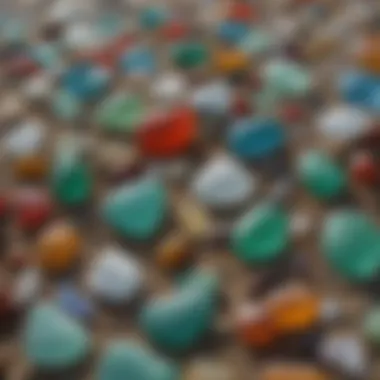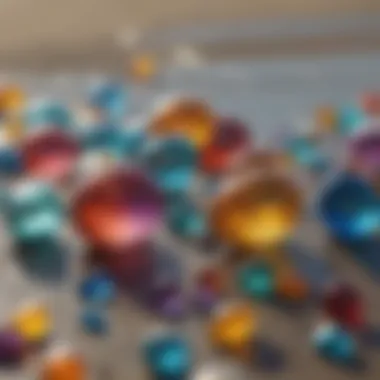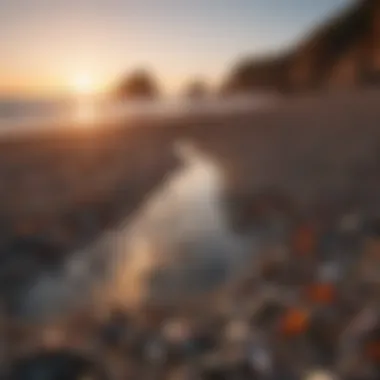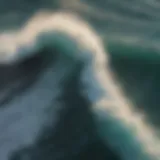Exploring Glass Beach: Nature's Unique Kaleidoscope


Intro
Nestled along the rugged coastline of Northern California lies a remarkable destination: Glass Beach. This beach is not just another stretch of sand meeting the sea; it represents a one-of-a-kind showcase of nature's resilience and creativity. The vibrant remnants of glass, polished by the relentless waves into smooth, colorful gems, narrate a history steeped in environmental evolution and human impact.
Once a place where discarded bottles and refuse floated ashore, Glass Beach has transformed dramatically over the decades. It invites countless visitors—whether they hail from nearby towns or across the globe—to witness its unusual beauty. Embracing the juxtaposition of human negligence against nature's restorative power, this beach stands as a testament to reclamation and the importance of environmental stewardship.
In this exploration, we will delve into the historical significance that led to the formation of the beach, analyze the ecological implications of the sea glass phenomenon, and discuss ongoing preservation efforts to maintain its delicate ecosystem. You’ll gain insights into the unique experiences that this locale offers, underscoring the need for mindful interaction with nature.
Rather than a simple guide, consider this discourse a lens through which to appreciate the intricate tapestry of ecological relationships and conservation efforts that keep Glass Beach vibrant and accessible for future generations. Whether you're a seasoned ecologist or just someone looking for a unique spot to visit, you'll find something worthwhile in this narrative.
Prologue to Glass Beach
Glass Beach stands as a remarkable testament to nature's ability to reclaim and transform human-made objects into art. Nestled along the coastline of California, this beach is renowned not only for its unique beauty but also for its historical and environmental significance. For surfers and extreme sports enthusiasts, it presents an intriguing blend of adventure and education, embodying the spirit of exploration that drives many coastal aficionados.
When discussing Glass Beach, one must first appreciate its geographical context and the environmental forces at play that shaped it. The captivating allure of colorful sea glass, formed from broken bottles and glass debris, draws visitors from far and wide. These vibrant shards are not merely remnants of past human activity; they are an emblem of change, illustrating both the enduring impact of our wastefulness and the resilience of nature to adapt.
Geographical Location and Description
Located in Fort Bragg, California, Glass Beach is part of the rugged Mendocino coastline. The area features dramatic cliffs and the roaring Pacific Ocean, providing a stunning backdrop for anyone eager to bask in its unique offerings. The beach's terrain is equally captivating, with smooth, weathered glass fragments intermingling with the soft sand, creating a visual spectacle that feels both grounded and surreal. Visitors often find themselves enchanted, walking along the shore, entranced by the kaleidoscopic display beneath their feet.
The beach can be somewhat tricky to access, as it’s tucked away behind a series of surrounding cliffs, inviting a sense of adventure in getting there. Some paths are well-trodden, while others are a bit more rugged, perfect for the more daring spirits. The crystal waters that lap at the shore are often mixed with stretches of rocky outcrops and tide pools, fostering a diverse ecosystem that thrives in this unusual habitat.
Historical Context of Glass Beach
To understand the significance of Glass Beach, it's vital to delve into its history. The beach was initially a dumping ground for glass, debris, and other waste from the nearby town—essentially, a landfill by the sea. As time marched on and the area's waste management practices evolved, the beach transformed from an eyesore to an exceptional natural wonder.
The history of Glass Beach reflects a broader narrative about human impact on the environment. From around the early 1900s until the 1960s, waste was carelessly discarded here. But nature played a remarkable role in this timeline; through weathering and natural erosion, those discarded items were broken down and smoothed into the beautiful sea glass that current visitors marvel at today. This transformation speaks volumes about resilience—of the earth's processes and the visitors who have since come to treasure the beauty hidden within what used to be viewed as waste.
Understanding Glass Beach isn't just about appreciating its beauty; it's also about recognizing the lessons it teaches us. The beach stands as a monument to the past, illustrating both the consequences of human actions and the possibilities of redemption and renewal. Now, as we continue to explore this unique locale, one cannot help but be moved by its dual story of loss and beauty, inviting everyone to consider their environmental impact.
"Glass Beach is not just a feast for the eyes; it's a reminder that beauty can arise from past mistakes."
As we progress through the exploration of this stunning destination, we delve deeper into the natural processes that have formed its sea glass and the ecological significance that arises from this reclaimed space.
Formation of Sea Glass
The journey of glass transforming into vibrant sea glass is not only fascinating but also crucial to understanding the allure of Glass Beach. This process of formation tells a tale of natural reclamation, through which discarded glass becomes a part of the coastal landscape, creating visually stunning treasures. In this article, we will explore how environmental factors and human activity have come into play in shaping this unique phenomenon.
The Process of Weathering
Natural Elements Involved
Weathering isn't just about aging or decay; it’s about the dance between natural elements and objects, particularly those discarded artifacts like broken bottles. Factors such as sand, salt water, and weather conditions each play their part. The waves — relentless and powerful — crash onto the shore, creating a robust environment where glass shards are tumbled, smoothed, and polished over time. Each wave is like a sculptor chiseling away sharp edges, turning hardened glass into soft, colorful gems.
One of the key characteristics of weathering is how it enhances the aesthetic appeal of sea glass. As the glass contends with sand and surf, its surfaces evolve, offering unique shapes and hues that are often more appealing than untouched artifacts. On Glass Beach, these elements come together to produce glass pieces that glitter under the sunlight like precious jewels, drawing countless visitors who treasure these natural works of art.
However, there are disadvantages too. Intense weather conditions can sometimes wash away unique glass pieces before they’ve had the chance to be seen by curious beachcombers.


Timeframe for Transformation
The transformation from sharp-edged rubbish to smooth, colorful sea glass doesn’t happen overnight. Depending on various factors, it can take years, even decades, for the glass to be fully weathered into its final form. Understanding this timeframe provides a deeper insight into the relationship between neglect and beauty.
One significant aspect of this transformation is the gradual change that glass undergoes due to the elements it encounters. While the time taken may seem lengthy, it can be beneficial for ecosystems that rely on slow change for balance. The unique feature here is patience; nature is forever at work, slowly converting human waste into a treasure.
However, the prolonged process can pose challenges too. If the beach is not protected, the pieces can be swept away by strong tides before they fully mature into the stunning sea glass we cherish.
Human Impact on Formation
Historical Waste Disposal
It’s crucial to address the historical waste disposal practices that have contributed to the formation of sea glass. In the early 20th century, areas around Glass Beach were used as dumping grounds for all kinds of refuse, including glass containers. This was a time when the importance of waste management was not recognized. Thus, heaps of glass were left to be molded by nature.
The key characteristic of this aspect is its ironic twist. The waste that once marred the landscape has, over the years, been transformed into beloved sea glass. This transformation holds a certain beauty while simultaneously highlighting the disregard humans once had towards waste and the environment.
However, this also raises concerns about the impact of such practices. The excessive glass and debris can lead to beach erosion and environmental degradation, calling for strict waste management policies.
Oceanic Contributions
The ocean also plays a pivotal role in the shaping of sea glass. Waves are relentless; they not only weather the glass but also redistribute the pieces across the beach, making collection a delightful treasure hunt. When strong storms roll in, they can uncover buried glass, introducing fresh pieces that previously lay beneath the surface.
The primary characteristic of oceanic contributions is variety. Different regions have distinct ocean currents that can transport materials worldwide. This adds an international twist to the sea glass found; one might stumble upon Japanese glass fragments mingling with pieces from American bottles, reflecting a mosaic of human activities across the globe.
However, while this transportation assists in diversity, it can also lead to loss where certain pieces may never return home, swept away by unpredictable tidal forces.
As we traverse the beach, it becomes clear that the formation of sea glass is a testament to resilience—both of the natural world and the remnants of human existence. Understanding these processes not only enriches our appreciation of Glass Beach but also prompts a reflection on our role in environmental stewardship. But remember, this remarkable locale also deserves to be treated with respect; it's not merely a playground, but an evolving landscape that mirrors the intertwining of waste and beauty.
Ecological Significance
Understanding the ecological significance of Glass Beach reveals much more than the beauty of its vibrant sea glass. The beach is not just a whimsical display of colors; it's a vivid example of how human waste can intertwine with natural processes. The significance of this beach encompasses various aspects, including its role as a habitat for marine life and its interaction with the larger environmental system. By focusing on these elements, readers can gain insights into not only the beach itself but also the environmental challenges that threaten such delicate ecosystems everywhere.
Habitat for Marine Life
Flora and Fauna Interactions
The interactions between flora and fauna at Glass Beach paint a fascinating picture of life where ocean meets land. Here, the coastal plants, like sea oats and beach grass, provide essential shelter while helping to stabilize the sand dunes. In turn, these plants invite various species of insects and birds which play critical roles in pollination and nutrient cycling. A standout feature of these interactions is the growth of certain algae and seaweed in the presence of sea glass, which offers a unique surface for marine organisms to cling onto, fostering an environment rich in biodiversity.
Every little part creates a blanket of life – from small crabs scuttling around seeking refuge, to birds pecking at the food sources these habitats provide. This cyclical relationship emphasizes why the habitat is crucial: it provides resources, sustenance, and protection to countless creatures unique to this shoreline.
Biodiversity Considerations
Biodiversity is vital to the sustainability of environments like Glass Beach. The key characteristic here is the multitude of species that can thrive due to the diverse habitats created by the blend of land and marine ecosystems. The variety allows for resilience, meaning that if one species faces extinction, others may fill in the gaps they leave. This complex web of interactions enhances the overall health of the ecosystem.
A notable unique feature is that the presence of sea glass creates microhabitats that can support specialized organisms. These peculiar systems can be both a boon and a bane, as some species thrive and others may struggle. A higher level of biodiversity generally means a more resilient ecosystem, making it a vital aspect worth maintaining at Glass Beach.
Environmental Balance
Role of Beach Ecosystems


Beach ecosystems, like the one at Glass Beach, do far more than provide a pretty backdrop for sunbathers. Their role is pivotal in maintaining the balance of coastal environments. The dynamic interplay between land and sea encourages sediment movement and nutrient cycling, helping to mitigate coastal erosion. One of the most notable characteristics of these ecosystems is their buffering ability against strong ocean currents and storm surges, which can be vital in protecting inland areas.
These systems, however, are precarious and rely on healthy human practices to remain intact. They are a beneficial choice for highlighting our need for sustainable coastal management, as they can offer clues about how to adapt and adjust to changing environmental conditions.
Impact of Sea Glass on Sand Composition
The impact of sea glass on the sand composition at Glass Beach is a remarkable phenomenon that illustrates the interconnectedness of different environmental factors. The key characteristic of this impact is the alteration of sand texture and chemical makeup, which can influence the types of organisms that inhabit the area. Sea glass can add vital minerals back into the ecosystem, potentially enhancing the growth of some plant species by improving soil quality.
However, there’s a downside worth considering – over time, too much glass may disrupt the natural sediment balance, which could harm certain native species. This duality highlights why it’s essential to educate visitors regarding the impacts of their activities as they enjoy this unique environment. Understanding these layers of ecological significance can foster a deeper appreciation for Glass Beach and the nuances of its ecosystem.
Conservation Efforts
Conservation efforts for Glass Beach are vital in maintaining its unique ecosystems and the stunning beauty that draws visitors from afar. The interplay of human activity and natural restoration has created a delicate balance which requires ongoing attention. Without proper measures in place, the beach risk losing its breathtaking charm and ecological significance. Thus, understanding the regulations and community initiatives surrounding Glass Beach can foster greater visitor awareness about their role in preservation.
Protection Regulations
Local Policies
Local policies regarding Glass Beach reflect a commitment to sustainable tourism. These regulations often encompass guidelines intended to protect the beach's unique allure. One specific aspect of these policies is the enforcement of restricted access to certain areas. By limiting foot traffic in sensitive zones, the local governance can better safeguard fragile habitats. This characteristic of local policies is not only about preventing overuse, but also about fostering respectful human interaction with nature.
The uniqueness of these policies comes with the advantage of preserving rare plant species and local wildlife. However, some locals argue that these restrictions may hinder people's enthusiasm for exploration. Still, it's crucial to weigh the benefits of ecological integrity against the desire to roam freely.
Visitor Guidelines
Visitor guidelines are another pillar of conservation at Glass Beach. These guidelines are designed to enhance the experience while minimizing environmental impact. One key characteristic of these guidelines is the emphasis on education. Visitors are encouraged to learn about the ecological importance of sea glass and the beach’s flora and fauna.
A standout feature of these guidelines is the promotion of "Leave No Trace" principles, which advocate for minimizing one's footprint on the beach. This proactive approach is beneficial in maintaining the beach's charm and keeping it clean for all those who visit. The downside might be that not all visitors fully understand or comply with these guidelines, potentially leading to a decline in beach conditions if ignored.
Community Involvement
Support Groups and Initiatives
Community involvement plays a crucial role in the conservation of Glass Beach. Various support groups and initiatives have emerged, focused on raising awareness about the beach's ecological significance. One specific aspect is the organization of educational seminars that delve into the beach’s history and the importance of maintaining its natural beauty. This characteristic makes them a popular choice for fostering greater public understanding.
The unique feature of these groups is their collaborative approach, often partnering with local schools and environmental organizations. By doing so, they create an engaged community that not only appreciates the beach but also actively participates in its preservation. The challenge, however, is ensuring continuous engagement, especially with younger demographics who may not always see the direct benefits of long-term conservation efforts.
Volunteer Clean-Up Drives
Volunteer clean-up drives are a direct way to combat litter and maintain the natural landscape of Glass Beach. These initiatives usually involve local residents and tourists coming together for a common cause. The highlight of these drives is the sense of camaraderie and shared responsibility that arises when people work together towards a greater goal.
The uniqueness of volunteer clean-up drives is that they often include educational components that teach participants about the impacts of pollution. Besides the immediate benefits of cleaning, they contribute to fostering a community ethos around environmental stewardship. However, the downside can be fluctuating participation rates, often influenced by the season or other community events, which can affect the overall impact of these drives.
In sum, the conservation efforts surrounding Glass Beach encapsulate a collective responsibility, merging regulatory frameworks with community activism. The future of this unique environment rests in the hands of both policymakers and passionate individuals who care deeply about its preservation.
Visitor Experience
Understanding what visitors can expect when they arrive at Glass Beach is paramount to fully appreciating its unique allure. The experience of this coastal gem extends beyond just looking at vibrant pieces of glass strewn across the shore. It's about one’s connection with nature, the thrill of discovery, and engaging with an ecosystem that has endured both human interference and natural elements. Visitors here often walk away with much more than just a collection of colorful glass; they build memories, insights, and a deeper appreciation for environmental preservation.
Attractions and Activities


Beachcombing for Sea Glass
Beachcombing for sea glass presents a quintessential experience at Glass Beach. This activity invites individuals to sift through sandy shores, uncovering the polished remnants of discarded bottles and other glass items, transformed by the relentless dance of ocean waves and time.
The thrill lies in finding rare pieces that shimmer in the sunlight, showcasing a variety of colors and even shapes. Notably, some enthusiasts share tales of finding particularly exotic glass shards, igniting a sense of competition and camaraderie among visitors. This simple yet rewarding task undeniably enhances one’s connection with the environment while promoting a sense of ownership and responsibility for nature.
However, it’s important to note the ethical considerations lurking beneath. As beautiful as these glass pieces may be, over-collecting can pose threats to the delicate balance of the coastal ecosystem. Thus, balance is crucial—leaving some treasures allows others to enjoy the same excitement you did.
Photography Opportunities
Glass Beach stands out as a photographer’s paradise, where the interplay of light against colorful glass leads to visually stunning shots. The unique juxtaposition of glimmering sea glass against the rugged backdrop of the coastline creates memorable compositions waiting to be captured.
Every angle offers something different—sunrise and sunset bathes the beach in golden hues, amplifying the glass's inherent beauty. The tranquil blue waves provide a contrasting backdrop, making any picture pop with vibrancy. For amateur and professional photographers alike, the beach allows for creative freedom and exploration.
That said, photographers should remain mindful of their impact. It isn’t just about snapping the perfect shot; respecting the environment during this pursuit is essential. Finding the balance between showcasing nature’s beauty while practicing sustainable photography contributes positively to both the art and preservation of this remarkable site.
Best Practices for Visitors
Respect for the Environment
Respecting the environment at Glass Beach is a cornerstone of any visitor's experience. This notion goes beyond merely enjoying the scenery—it's about ensuring that this beautiful locale stays intact for future generations. Visitors should be encouraged to take the time to understand local flora and fauna, fostering an appreciation for the delicate balance of marine ecosystems.
By adhering to the principle of mindfulness, visitors can minimize disturbances to both wildlife and plant life. For instance, staying on designated trails helps protect native vegetation—some of which may be endangered or sensitive to foot traffic. Plus, actively participating in clean-up efforts, even if just picking up loose litter, can amplify one’s own experience while benefitting the broader community.
Leave No Trace Principles
The Leave No Trace principles emphasize a collective responsibility for maintaining the integrity of Glass Beach. Practicing these principles helps protect and preserve the natural beauty of the surroundings. Each visitor can make decisions that minimize their impact, such as packing out what you pack in, which not only keeps the area pristine but also sets a positive example for others.
Embracing Leave No Trace extends beyond just avoiding litter; it encompasses being conscientious about where one sits or sets up equipment, and even how one interacts with wildlife. All these actions lay the groundwork for a sustainable future where both human visitors and nature can coexist harmoniously.
"Each small action of respect contributes to a greater impact on the environment, ensuring that places like Glass Beach remain untouched and wild."
Visitors to Glass Beach have the opportunity to engage deeply with nature while adhering to practices that promote sustainability and respect. This enhances the overall experience, making a trip not just enjoyable, but meaningful and responsible.
Epilogue
The intricate relationship between nature and human activity at Glass Beach reflects a profound narrative worth considering. As this article illustrates, the colorful sea glass, born from discarded waste, illustrates not only nature's resilience but also our responsibility towards the environment. The juxtaposition of beauty and the remnants of human action paints a vivid picture of life's complexities.
Reflecting on Nature's Artistry
When we stroll along Glass Beach, we’re not just viewing patches of glimmering colors, but we also witness nature honing its artistic skills. Over years, shards of glass have been polished by ocean waves, turning them into smooth gems, a testament to time's power. Each piece tells a story—some fragments come from bottles long forgotten, while others may hail from more recent cases. After all, when we speak of nature’s artistry, it's about the transformation of the mundane into something striking. The interplay between the serene ocean and fragmented remnants creates a unique visual spectacle, resembling an ever-changing canvas.
A walk here brings to mind how art can emerge from destruction, forcing us to reconsider our impact on the natural world. Visitors often find themselves captivated by the vibrant colors scattered throughout the sand, marveling at how something initially deemed waste can be transformed into a striking landscape. This thought-provoking sight encourages reflection on what else can be recycled or reclaimed in our daily lives.
The Future of Glass Beach
Looking towards the future, the prospect for Glass Beach stands at a crucial crossroads. While the ongoing weathering process continues to gift visitors with beauty, the environmental implications warrant attention. Conservation efforts are ever critical, as they have the potential to safeguard this beach's unique ecosystem. Local policies need to evolve in tandem with the increasing numbers of tourists, so as to not overwhelm the delicate balance that exists here.
Participation from the community plays a pivotal role in the future of Glass Beach. Engaging local citizens and visitors alike in educational initiatives can cultivate a better understanding of sustainable practices and the significance of preserving natural wonders. For example, promoting clean-up events or creating public art installations that incorporate sea glass can benefit both the environment and community spirit.
If we want to continue cherishing Glass Beach as a testament to nature’s beauty, it’s our duty to tread lightly, respecting its fragility while enjoying its splendor. Through collective awareness and effort, the allure of this exceptional location can be preserved for generations to come, ensuring that future visitors can experience the same enchanting ambiance.
"Preserving beauty begins not just with admiration but action."
Maintaining and embracing the significance of places like Glass Beach is essential, as they remind us that beauty can emerge from our past mistakes, urging us toward a brighter, more mindful future.







